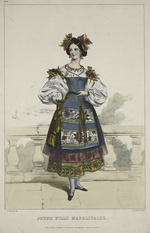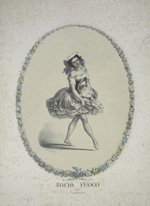Romanticism: Italian National Dance
Customs
of the Region of Preta in the Province of Aquila
Color
etching by Pinelli, Rome, 1808. This
picturesque image, set in the mountainous area of the Abruzzi, depicts a couple
dancing the saltarello. A folk dance
typically performed by couples, the saltarello was popular throughout central and
southern Italy. Although more closely
associated with Spanish dance forms, castanets as well as tambourines often
appear in depictions of Italian folk dances.
Cia Fornaroli Collection, Jerome Robbins Dance Division.
Lise
Noblet as Fenella in La Muette de Portici (The Dumb Girl of Portici)

Lise Noblet
Color
lithograph by Achille Devéria, Paris, [184-].
First performed at the Paris Opéra in 1828,
La Muette de Portici
was an opera-ballet with music by Daniel Auber, choreography by Jean-Louis
Aumer, a singing hero (the fisherman Masaniello), and a dancing heroine (the
mute Fenella). The work, set in Naples
during a seventeenth-century revolt against the Spaniards, capitalized on the
Romantic era's fascination with local color, evident in the treatment of
Fenella's costume. Many French works of
the Romantic period had Italian settings and featured classicized versions of
Italian folk dances. Cia Fornaroli
Collection, Jerome Robbins Dance Division.
Lucile
Grahn in the title role of Catarina, ou La Fille du Bandit (Catarina, or
The Daughter of the Bandit)
Color
engraving, [Leipzig, ca. 1848].
Choreographed by Jules Perrot in 1846 and performed (albeit in a
somewhat different version) at Rome's Teatro Argentina two years later, Catarina
opened in the "wild and picturesque" hills near Rome, where the
seventeenth-century painter Salvator Rosa has fallen into the hands of women
bandits from the Abruzzi led by the beautiful Catarina. In addition to the celebrated Pas
Stratégique for Catarina and her musket-bearing amazons, the ballet
included popular and masked dances that conveyed the atmosphere of Rome during
Carnival time. Jerome Robbins Dance
Division.
Sofia
Fuoco dancing the Tarantella

Sofia Fuoco
Color
lithograph by Niccolò Sanesi, Florence, [ca. 185-]. Trained by Carlo Blasis, Sofia Fuoco made her
debut at La Scala when she was only thirteen, quickly rising to the coveted
position of
prima ballerina assoluta.
She soon crossed the Alps, where she aroused the enthusiasm of French
audiences and the admiration of critics such as Théophile Gautier. A dancer of fiery temperament (Fuoco, a stage
name, means "fire" in Italian), she combined a vivid personality with
a dazzling technique. Cia Fornaroli
Collection, Jerome Robbins Dance Division.
The
Tarantella in Pasquale Borri's L'Etoile de Messine (The Star of Messina)
Color
lithograph by Régnier, Joseph Bettannier, and Morlon from a painting by Morlon,
Paris, [186-]. A student of Carlo
Blasis, Pasquale Borri made his debut at La Scala, remaining there as primo
ballerino di rango francese (or "first male dancer of French
rank") until 1842. In the decades
that followed he danced throughout Italy, partnering Fanny Cerrito, Amalia
Ferraris, Augusta Maywood, and Carolina Pochini, the ballerina he finally
married. A dancer of elegance and
vitality, he was equally successful as a choreographer.L'Etoile de Messine, which premiered
in Vienna in 1856 as Die Gauklerin (The Juggler), was revived as La
Giocoliera in Milan, Trieste, Rome, and Venice, and lavishly recreated
(with new music and a new libretto) at the Paris Opéra in 1861 with a title
emphasizing the Sicilian setting, was one of his best known works. A high point of the Paris version (which had
a new libretto by Paul Foucher and a new score by Count Nicolò Gabrielli) was
the rousing tarantella led by Ferraris in the tragic role of Gazella and Louis
Mérante. Jerome Robbins Dance Division.
Statistical, Political, and Mineralogical Map of Italy, with All Post
Roads, Relays, and Distances, and the New Borders, Based on the Latest Treaties,
Drawn up, Engraved, and Dedicated to His Majesty the Emperor of Austria,
King of Hungary, Bohemia, and Italy, etc., etc.
Map engraved by J. A. Orgiazzi, Paris, 1816. After the collapse of the Napoleonic
empire in 1814, Italy was divided into more than a half-dozen states--the Kingdom
of Sardinia (Piedmont), Grand Duchy of Parma and Piacenza, Duchy of Modena,
Grand Duchy of Tuscany, Principality of Lucca, Papal States, and the Kingdom
of Naples--under the domination of Austria. This map, engraved in 1816 for
the Emperor of Austria, who also claimed the title of King of Italy, shows
the new political order. The Lionel Pincus and Princess Firyal Map Division,
The New York Public Library
Johnston's War Map of Italy
Map. Lithograph by W. and A. K. Johnston, 1860. In the decades following
the post-Napoleonic division of Italy, the struggle for national unification
intensified. By 1860, when this "war map" was made, most of the
north, including Lombardy, Parma, Modena, Lucca, Tuscany, and Romagna, had
voted to join the Kingdom of North Italy under the leadership of the House
of Savoy. Meanwhile, in the south, Garibaldi and his Redshirts were fighting
the Bourbon armies of the Kingdom of Naples, which quickly collapsed, and by
the end of the year its citizens too had voted for union with the north. Although
Venetia and the Papal States did not become part of the new country until 1866
and Rome until 1870, the Kingdom of Italy was proclaimed in 1861. The Lionel
Pincus and Princess Firyal Map Division, The New York Public Library.